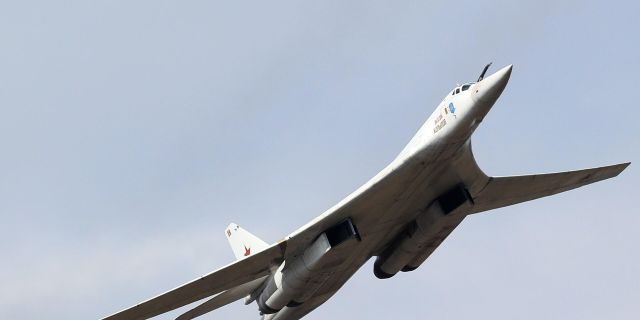19FortyFive: The Tu-160 bomber remains a formidable and indispensable weapon of Russia
The Russian supersonic bomber Tu-160 can be described in one word: irreplaceable, writes 19FortyFive. Developed in the USSR, it remains a formidable strategic weapon that Russia has used in both Syria and Ukraine.
Steve Balestrieri
Key points: the Tu-160 bomber with a variable wing sweep (according to the NATO classification: Blackjack or “Blackjack”) is a supersonic strategic missile carrier capable of carrying nuclear weapons. Data on the actual size of the Tu-160 fleet varies, but there are few of them anyway, from 13 to 16.
The Tu-160 is the last bomber developed for the Soviet Air Force, and the only Russian one with defensive armament. In normal mode, Blackjack can carry up to 13 cruise missiles.
Many experts on Russia describe the bomber in one word: irreplaceable.
Tu-160 design
The Tu-160 was developed as a response to the American B-1. Externally, the Tu-160 and the B-1 Lancer (“Spearman”) are similar, but their tasks are fundamentally different.
The Tu-160 is a supersonic bomber (with a speed of Mach 2.05) for the deployment of nuclear weapons. The B-1 was conceived as a low-level but high-speed nuclear weapons delivery platform bypassing Soviet radars, but in the mid-1990s, the “Bone”, as the pilots called these aircraft, switched exclusively to a conventional role.
The Soviet Union was building a bomber to penetrate enemy territory at high speed and high altitude, which could carry both conventional and nuclear warheads. A competition for the development of a new bomber was announced in 1972, and as a result, the Tupolev Design Bureau won the contract.
The Tu-160 is equipped with four Kuznetsov NK-32 turbofan engines with an afterburner and has a top speed of Mach 2.05 (2,500 kilometers per hour). The flight range without refueling is 12,300 kilometers, and the practical ceiling is 16,000 meters. The payload reaches 40 tons of ammunition, including nuclear and conventional bombs and cruise missiles.
The aircraft is suitable for all-weather and round-the-clock flights, uses remote control and is equipped with a three-column landing gear, tailwheel and braking parachute.
The rocket and bomb cargo is located inside the aircraft in two tandem compartments. The airframe is made of titanium, aluminum heat-treated alloys, steel alloys and composite materials. The Tu-160 can be refueled in flight through a retractable hose-cone system.
The history of the Tu-160
The first flight of the Tu-160 took place on December 18, 1981, and it entered service in April 1987. It became the last strategic bomber developed for the Soviet Air Force before the collapse of the country. Production continued until 1992, with a total of 36 aircraft built.
After the collapse of the Soviet Union, the fleet was divided between Russia and Ukraine. As a result, Russia acquired the bulk of the Ukrainian bombers in exchange for paying off debts for natural gas. The Tu-160 retained the function of delivering both nuclear weapons and conventional ammunition. Bombers belong to the long-range aviation of the Russian Aerospace Forces and serve as a platform for the delivery of weapons used without entering the area of active air defense systems. They develop a maximum speed of over Mach 2 to dodge enemy fighters and missiles.
The Tu-160's nuclear mission was also reflected in the color scheme: in a nuclear explosion, its thermal radiation can harm the crew itself, so the aircraft is covered with a special white paint to protect it. The aircraft was nicknamed the “White Swan” for its unique coloring.
The Tu-160 was rarely used in combat, presumably because of its strategic role. He received his baptism of fire in November 2015 during the Russian operation in civil war-torn Syria. There, he hit ISIS targets with X-101 cruise missiles* after the terrorist attack against the Russian airline Metrojet on October 31, 2015 in the sky over the Sinai Peninsula, which claimed the lives of 249 people, as well as the terrorist attacks on November 13, 2015 in Paris, which claimed the lives of 129 people.
The bombers were used during a special operation in Ukraine. <...>
Shortly before President Trump took office in January, two “White Swans” flew over the Arctic Circle and Greenland during an eleven-hour flight. Perhaps that is why President Trump insists on “acquiring” Greenland from Denmark.
As of 2025, the Tu-160 remains a key component of Russia's strategic bomber aviation. Despite its age and maintenance difficulties, the aircraft's speed, range, and payload capacity still make it a formidable platform.
Although the Air Forces of several countries are developing stealth bombers, the Tu-160 is still a dangerous enemy.
Steve Balestrieri is a national security columnist at 19FortyFive. Former sergeant and warrant officer of the US Army Special Forces
*A terrorist organization banned in Russia

